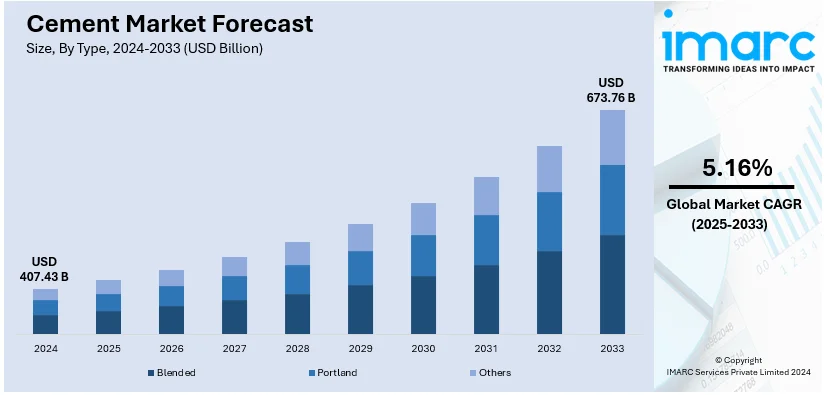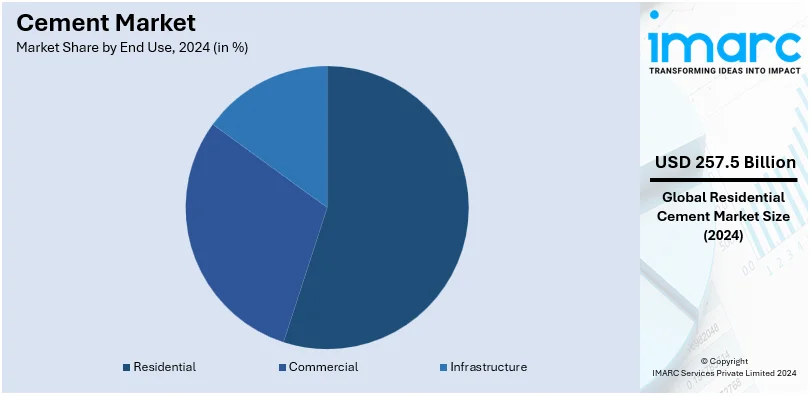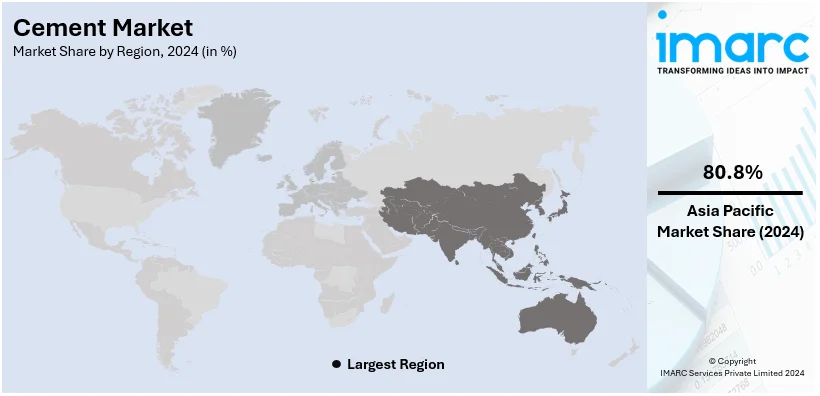
Cement Market Size, Share, Trends and Forecast by Type, End Use, and Region, 2025-2033
Global Cement Market Size, Share, Growth, & Forecast:
The global cement market size was valued at USD 407.43 billion in 2024, and is projected to reach USD 673.76 billion by 2033, growing at a CAGR of 5.16% during 2025-2033. In 2024, Asia Pacific emerged as the leading region in the industry, accounting for over 80.8% of the global cement market share. This regional market is mainly propelled bolstering construction activities, amplifying urbanization, and growing infrastructure projects.
|
Report Attribute
|
Key Statistics
|
|---|---|
|
Base Year
|
2024
|
|
Forecast Years
|
2025-2033
|
|
Historical Years
|
2019-2024
|
|
Market Size in 2024
|
USD 407.43 billion |
|
Market Forecast in 2033
|
USD 673.76 billion |
| Market Growth Rate (2025-2033) | 5.16% |
The global cement market is mainly impacted by elevating construction projects that are generally prompted by population proliferation and booming urbanization, especially in developing economies. Magnifying investments in infrastructure advancements, encompassing housing, roads, and bridges ventures, substantially bolster requirement. In addition to this, technological innovations in manufacturing methodologies and the production of sustainable and energy-saving cement products foster market expansion. Moreover, magnifying environmental consciousness has resulted in advancements in low-carbon cement and recycled material incorporation, aligning with stricter regulatory frameworks. Additionally, government-led initiatives to modernize public infrastructure and industrial facilities further enhance the market's expansion, positioning it as a cornerstone of the construction sector.

The United States is a key contributor to the global cement industry, driven by robust building projects spanning housing, business facilities, and public infrastructure. Government investments in infrastructure modernization, including roads, bridges, and public facilities, are significantly providing a boost to the cement market demand. Furthermore, the market benefits from the presence of advanced manufacturing facilities and innovative technologies aimed at improving production efficiency and sustainability. Stricter environmental regulations are also encouraging the adoption of eco-friendly cement solutions. With steady economic growth and ongoing urban development projects, the U.S. cement industry remains a critical player in shaping global trends and driving industry advancements. For instance, in 2024, the United States witnessed an increase in the planned conversion of outdated office spaces into residential apartments, with the number reaching 55,300 units.
Cement Market Trends:
Growing Population and Rapid Urbanization
The rapid population growth and urbanization across the globe are primary drivers boosting the cement market share. According to the United Nations, the world's population is predicted to grow by approximately 2 Billion over the next 30 years. Expanding global population has led to the heightened need for infrastructure and housing, which extensively utilize cement for various construction projects. Furthermore, the United Nation has predicted that global urban population will increase to two-third by 2050. This rising trend necessitates the development of new cities, roads, bridges, and other infrastructure projects, which increases the cement industry share. Moreover, the heightened need to accommodate a growing population and provide suitable living and working conditions is promoting the global cement market growth.
Government Initiatives and Investments in Infrastructure Projects
According to the cement industry research report, governments across globe are acknowledging the value of building foundational systems to support economic advancement and improve quality of life. In line with this, they are allocating considerable resources to create and improve transportation networks, including roads, highways, trains, and airports. For example, the US Department of Transportation revealed in 2022 that public and private investment in transportation infrastructure and equipment reached USD 403.9 Billion, accounting for 7.4 percent of the overall investment of USD 5,476.1 Billion. According to the cement market forecast, the heightened investment in these activities creates the need for vast volumes of cement to build long-lasting and dependable infrastructure, boosting the adoption of efficient and durable cement. Furthermore, the introduction of various requirements that stimulate the use of ecologically friendly cement, consequently increasing the growth rate of green cement to (CAGR) 10.7% between 2024 and 2032, is propelling the market growth.
Expanding Real Estate Sector
According to the cement industry overview, the rising real estate sector is another key driver strengthening the global market growth. As economies expand and wages rise, so does the demand for houses, commercial properties, and other real estate assets. According to the IMARC analysis, the real estate industry is predicted to reach USD 8,654 Billion by 2032, growing at a 1.9% CAGR from 2024 to 2032, leading to an increase in building activity. Residential, commercial, and industrial buildings are among the many areas of the real estate industry that require cement for foundations, walls, floors, and other structural parts. Furthermore, urbanization, population increase, and changing lifestyles add to the need for contemporary and visually pleasing structures, boosting the market growth.
Cement Industry Segmentation:
IMARC Group provides an analysis of the key trends in each segment of the global cement market, along with forecast at the global and regional levels from 2025-2033. The market has been categorized based on type and end use.
Analysis by Type:
- Blended
- Portland
- Others
Portland leads the market with around 47.5% of market share in 2024. This dominance can be attributed to its great durability and strength, making it suitable for a variety of building applications. The IMARC Group projects that the Portland cement industry will reach 3.1 billion tons by 2032, with a 3.2% compound annual growth rate (CAGR) from 2024 to 2032. The growing popularity of the product, that possesses a high compressive strength and is capable of handling huge loads and adverse weather conditions, is boosting the cement market share. It is also adjustable in terms of composition, allowing for changes to meet specific project requirements. Furthermore, Portland cement has faster hardened and setting durations than other cement types, reducing manufacturing time and increasing efficiency.
Analysis by End Use:

- Residential
- Commercial
- Infrastructure
Residential leads the market with around 63.2% of market share in 2024. In line with the global cement industry statistics, the residential segment leads the market due to several significant characteristics, including rising housing demand, which is being driven by population expansion, rapid urbanization, and increasing disposable incomes. Residential building projects, which include single-family houses, apartments, and condominiums, provide a substantial contribution to the global cement market growth. Furthermore, residential constructions require a huge quantity of cement for their foundations, roofing, flooring, and other structural components, which serves as a key driver stimulating the market growth. Along with this, cement's strength, durability, and adaptability make it an excellent choice for constructing safe and long-lasting residential building projects.
Regional Analysis:

- North America
- Asia Pacific
- Europe
- Latin America
- Middle East and Africa
In 2024, Asia Pacific accounted for the largest market share of over 80.8%. Asia-Pacific is the leader in cement markets, accounting for over 55% of global cement consumption in 2023, as per an industrial news article. Rapid urbanisation and industrialization are also strong drivers across China, India, and Indonesia. Owing to high levels of urban housing and infrastructure construction, China is the world's leading cement producer, producing around 2,100,000 metric tonnes in 2023. The country that is closest to China in the production of cement is India, according to the data from the World Population Review. Compared to 2022, when they produced 380,000 metric tonnes of cement, India produced 410,000 metric tonnes in 2023. Vietnam is second on the list with 110,000 metric tonnes produced in 2023 and 120,000 metric tonnes in 2021. India's "Smart Cities Mission" and large-scale projects like Bharatmala and Sagarmala are also significant factors. Demand is supported by the region's expanding population and increased foreign infrastructure projects. The goal of Southeast Asia's ASEAN Connectivity 2025 plan and other initiatives is to improve infrastructure, which will raise cement consumption. The usage of green and sustainable cement has increased, particularly in urban areas, because of governments' attention on reducing the environmental impact of construction activities.
Global Cement Market Regional Takeaways:
Cement Industry Analysis in the United States
In 2024, United States accounted for the 88.10% of the market share in North America. The main drivers of the cement market in the United States are robust infrastructure investment and urban expansion. The USD 1.2 Trillion allocated for projects that include public transportation, bridges, and highways in the U.S. Bipartisan Infrastructure Law is expected to considerably raise the demand for cement. The fact that 1.4 Million new residential units were constructed during 2022 speaks a lot to the strength in residential construction and how this further supports the cement sector. Of course, another driver has been the transition towards more green construction, with cement products like recycled and low-carbon cement gaining much attraction due to the increasing demand on sustainable cement products.
According to World Population Review data, the United States is expected to become the fourth-largest cement manufacturer, given that it produced 91,000 metric tonnes in 2023. Another major import is cement, mainly sourced from Mexico and Canada. Other innovations include 3D-printed building components and self-healing concrete, which slowly begin to take market share because of their affordability and durability advantages. Growing investments in renewable energy projects, such as wind turbine installations, which demand large amounts of cement for foundation, are increasing demand even more.
Cement Industry Analysis in Europe
Government infrastructure initiatives, urbanization, and stringent environmental regulations are driving the European cement market. The European Green Deal, which sets the target of achieving net-zero emissions by 2050, has fast-tracked the development of low-clinker cement and carbon capture technologies as environmentally friendly alternatives to cement. There are various types of kilns used in cement production. A European Union assessment of the cement industry reveals that about 78% of the cement production in Europe is now being done through dry process kilns, followed by 16% through semi-dry and semi-wet process kilns, and 6% through wet process kilns.
By 2030, the rehabilitation wave in the EU is aiming to renovate 35 Million buildings, and the region's market boom is also fuelled by the rehabilitation and retrofitting of aged structures. Yet, another major driver is renewable energy projects, especially offshore wind farms, whose growth is also picking pace. Digitization of the construction sector, which includes using Building Information Modelling, encourages the efficient and non-waste use of cement. An increase in the building activity in Eastern Europe and supported by the EU infrastructures is also driving the cement demand.
Cement Industry Analysis in Latin America
The primary drivers of the cement market in Latin America are urbanisation and the expansion of infrastructure. The two biggest cement manufacturers in 2023 were Mexico and Brazil, producing 50,000 metric tonnes and 63,000 metric tonnes, respectively, based on data from the World Population Review. Cement demand is increased by the growth of the urban population in the region, which fuels housing demand. In Chile and Colombia, for example, government investment in public infrastructure such as ports, bridges, and highways support market expansion. Moreover, green construction is being applied within the region, along with low-carbon cement being sought. Renewable energy infrastructural additions, such as Brazilian hydropower and onshore wind, are all stimulating demand for cement.
Cement Industry Analysis in the Middle East and Africa
Main factors driving the cement industry within Middle East and Africa End. This increase in cement demand for GCC countries comes from megaprojects like Saudi Arabia's NEOM metropolis and infrastructure built for the Emirates' Expo 2020. There is another one; one of the drivers for Africa's housing markets is that its urban population increases rapidly, leading to increased use of cement. Nigeria, as well as Egypt, together produces nearly 80 Million metric tons annually. Innovation in cement products is therefore encouraged by the region's emphasis on ecological and energy-efficient building techniques, driving the market.
Top Cement Companies, Manufacturers and Brands:
According to the cement industry price trend, the market is intensely competitive, due to the existence of huge international corporations, regional rivals, and small-scale manufacturers. To maintain a competitive edge, cement companies use strategies, such as mergers and acquisitions, product innovation, and regional expansion. Moreover, mergers and acquisitions allow companies to consolidate market share, get access to new technologies, and expand their customer base. For instance, in October 2024, Adani Cement announced strategic acquisition of Orient Cement for a heavy investment INR 8,100 Cr. This move is expected to minimize freight costs for Adani Cement and notably bolster its market share. Furthermore, they prioritize research and development (R&D) initiatives to increase the quality and sustainability of their cement products. In addition to this, cement companies are investing in ecologically friendly procedures and developing low-carbon cement solutions to decrease carbon dioxide (CO2) emissions during manufacturing.
The report provides a comprehensive analysis of the top companies, manufacturers and brands in the cement market with detailed profiles of all major companies, including:
- China National Building Materials Group Corporation
- Holcim Ltd.
- Anhui Conch Cement Co., Ltd.
- Jidong Development Group Co., Ltd.
- Heidelberg Materials
Latest News and Developments:
- December 2024: Al-Falah Al-Alami Company will invest USD 220 Million to construct a new cement plant in Jabal Saraj, north of Kabul. It is anticipated that the plant will lessen Afghanistan's reliance on cement imports.
- December 2024: Huaxin Cement announced that it will pay USD 1 Billion to acquire Holcim's majority holding in Lafarge Africa. The occasion represents a significant milestone in the global aspirations of the cement manufacturer established in China. In recent years, it has been connected in the financial press to numerous divestitures worldwide. However, this seems to be its biggest acquisition to date, and it contributes to what is turning into a significant international corporation in Sub-Saharan Africa.
- December 2024: Coolbrook, a company based in Finland, has formed a strategic alliance with Ambuja Cements to utilise its RotoDynamic Heater (RDH). The system reduces or eliminates the usage of fossil fuels to reach high temperatures in cement kiln pre-calciners by using electrical heat provided by renewable resources. There is currently no information available regarding the cost or which cement factories will receive the equipment upgrade. The agreement aims to support Ambuja Cements in attaining a 28% thermal substitution rate for alternative fuels and a 60% renewable energy share by 2028.
- December 2024: Siam Cement Group (SCG), a company located in Thailand, has announced plans to increase its output of SCG Low Carbon cement in southern Vietnam. It intends to provide local green-purchasing projects and export around 8000t/day of the product to Australia, the U.S., and Canada.
- November 2024: Cemex Holdings Philippines (CHP) streamlined its operations by selling Cemex Innovation Holding its whole interest in Swiss-based Cemex Asia Research (CAR) for USD 900,459. CHP and Cemex Innovation executed a share purchase agreement that included the selling of 118,849 shares.
Cement Market Report Scope:
| Report Features | Details |
|---|---|
| Base Year of the Analysis | 2024 |
| Historical Period | 2019-2024 |
| Forecast Period | 2025-2033 |
| Units | Billion USD |
| Scope of the Report | Exploration of Historical Trends and Market Outlook, Industry Catalysts and Challenges, Segment-Wise Historical and Future Market Assessment:
|
| Types Covered | Blended, Portland, Others |
| End Uses Covered | Residential, Commercial, Infrastructure |
| Regions Covered | Asia Pacific, Europe, North America, Latin America, Middle East and Africa |
| Companies Covered | China National Building Materials Group Corporation, Holcim Ltd, Anhui Conch Cement Co., Ltd., Jidong Development Group Co., Ltd., Heidelberg Materials, etc. |
| Customization Scope | 10% Free Customization |
| Post-Sale Analyst Support | 10-12 Weeks |
| Delivery Format | PDF and Excel through Email (We can also provide the editable version of the report in PPT/Word format on special request) |
Key Benefits for Stakeholders:
- IMARC’s report offers a comprehensive quantitative analysis of various market segments, historical and current market trends, market forecasts, and dynamics of the cement Industry from 2019-2033.
- The research study provides the latest information on the market drivers, challenges, and opportunities in the global cement market.
- The study maps the leading, as well as the fastest-growing, regional markets.
- Porter's five forces analysis assist stakeholders in assessing the impact of new entrants, competitive rivalry, supplier power, buyer power, and the threat of substitution. It helps stakeholders to analyze the level of competition within the cement industry and its attractiveness.
- Competitive landscape allows stakeholders to understand their competitive environment and provides an insight into the current positions of key players in the market.
Key Questions Answered in This Report
The cement market was valued at USD 407.43 Billion in 2024.
IMARC estimates the cement market to exhibit a CAGR of 5.16% during 2025-2033, reaching USD 673.76 Billion by 2033.
Key factors driving the cement market include population growth, urbanization, infrastructure investments, and continuous advancements in eco-friendly and sustainable cement products. In addition to this, the increasing number of government initiatives to modernize public infrastructure is significantly supporting the market.
Asia Pacific currently dominates the cement market, accounting for a share exceeding 80.8% in 2024. This dominance is fueled by rapid urbanization, industrialization, and major infrastructure projects in countries such as China, India, and Indonesia.
Some of the major players in the cement market include China National Building Materials Group Corporation, Holcim Ltd, Anhui Conch Cement Co., Ltd., Jidong Development Group Co., Ltd., and Heidelberg Materials, among others.
Need more help?
- Speak to our experienced analysts for insights on the current market scenarios.
- Include additional segments and countries to customize the report as per your requirement.
- Gain an unparalleled competitive advantage in your domain by understanding how to utilize the report and positively impacting your operations and revenue.
- For further assistance, please connect with our analysts.
 Inquire Before Buying
Inquire Before Buying
 Speak to an Analyst
Speak to an Analyst
 Request Brochure
Request Brochure
 Request Customization
Request Customization




.webp)




.webp)












